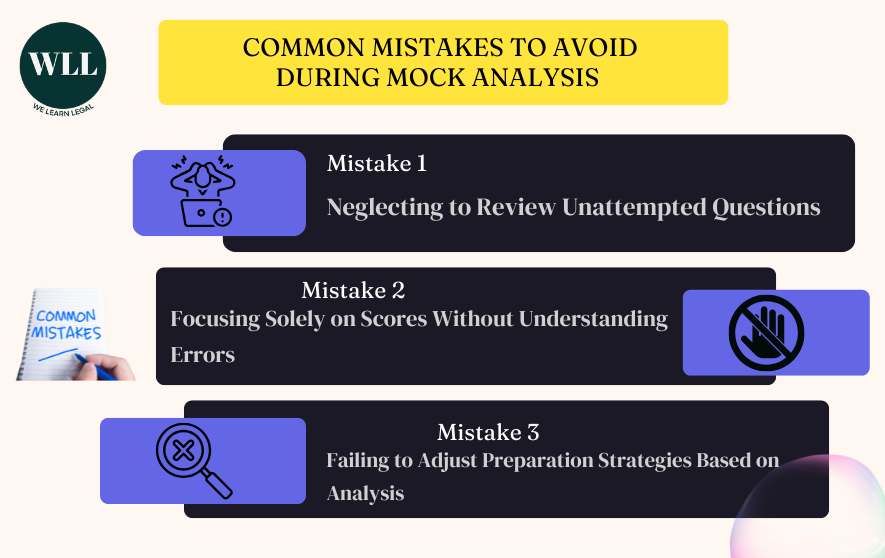Many CLAT aspirants fall into the trap of treating mock analysis as a formality rather than a real learning opportunity. This is one of the most common CLAT mistakes that can seriously impact your performance. In this blog, we’ll break down the typical errors students make during mock analysis, so you can avoid these common CLAT mistakes and make every mock test truly count.

Mistake 1: Neglecting to Review Unattempted Questions
You finish a mock, check your score, review your wrong answers, and move on. But what about the questions you didn’t attempt at all?
These unattempted questions are often the most revealing:
Were they skipped due to a lack of time? Did they seem too difficult or unfamiliar? Were you unsure of the concept?
For instance, say you left out a Reading Comprehension passage on constitutional law because the vocabulary was dense. That’s not just a time issue; it’s a comprehension gap that needs work. Or maybe you skipped two DI questions in Quant because you felt pressed for time. This signals a need to refine your section strategy.
Mistake 2: Focusing Solely on Scores Without Understanding Errors
Do not celebrate a high score or sulk over a low one. It is a mock, not the actual CLAT exam: Be grateful that you get to fix your mistakes before the real deal.
Here’s what not to do: Let us say your final score is 80 (80/150). DO NOT: feel disappointed. DO NOT: close the tab. DO NOT: move on to the next mock.
This approach is dangerous. CLAT isn’t just about numbers: it’s about performance patterns. A high score doesn’t mean you are exam-ready, and a low score doesn’t mean you’ve failed.
Let’s say you scored 100, but 10 of your correct answers were lucky guesses. Or, you scored 85, but made avoidable errors in questions you knew the answer to. Both outcomes deserve serious reflection.
This shift in mindset and a revisionist, analytical approach can completely transform your mock performance over time.
Mistake 3: Failing to Adjust Preparation Strategies Based on Analysis
Mock tests are meant to guide your prep, not just measure it. Yet many students make this mistake: they analyze a mock, realize what went wrong, and then continue with the same old study routine.
Making changes in your study plan is crucial. Without this, mocks lose their real value.
For example:
● If you keep getting Legal Reasoning wrong, maybe it’s time to switch to case-based questions or revisit past CLAT papers for exposure.
● If your time management is off, you might need to reorder sections during the mock or practice with a stricter timer.
Consider these tips:💡
- To learn about more common mistakes that CLAT aspirants are prone to, watch WLL’s video ‘5 CLAT Prep Mistakes Can Cost You Your Dream NLU’.
FINAL THOUGHTS
In the course of your preparation, mocks are the training grounds where you should feel free to make mistakes, reconvene, and strategize.
Remember, 50 mocks can teach you 50 different things. Not to mention, time management is best taught by repetitive mocks. Whether you’re scoring 60 or 120 right now, with focused mock analysis and strategic refinement, you can reach your dream score. Potential matched with routine, patience, and persistence is the key to CLAT success. If you feel like you are far from your ideal preparation stage and feel like giving up, take out 06:30 minutes and watch this video.
Frequently Asked Questions About Common CLAT Mistakes in Mock Test Strategy
Even the most dedicated CLAT aspirants often have lingering doubts about mock test strategy: you are not alone! Here are some of the most frequently asked questions we’ve heard from students just like you, answered.
Q1: How many mock tests should I take before CLAT 2026?
A: A good target is 30 to 40 full-length mocks by the time you reach the final month of your preparation. However, it is not just about numbers. The quality of analysis and the lessons you extract from each mock are far more important.
Alongside full-length mocks, sectional tests are equally important. Focus more on the sections you are weak in.
Maintain a tracker and try to take at least 2 mocks per week from August 2025 onward, increasing the frequency closer to the exam.
Q2: Should I focus more on accuracy or speed?
A: To start off, let me say there are no right answers. I know people who could not attempt enough questions, and despite answering with accuracy, they could not make the cut. Conversely, I know people who lost more marks than they scored, in negative marking. It depends on the cutoff, paper difficulty, and other factors. As a serious aspirant, you should be able to look at the paper, assess all these factors, and approach accordingly.
In the initial phase of preparation, accuracy is king. Focus on getting answers right, even if it takes you extra time. Once your accuracy stabilizes around 80–85%, you can gradually shift your attention to speed and time management.
It’s all about finding your balance.
If you’re getting 120 attempts with 60% accuracy, that’s 72 marks. But 100 attempts with 90% accuracy gives you 90 marks—a much better deal.
Q3: How soon should I analyze a mock test after taking it?
A: Ideally, you should analyze the mock on the same day, or within 24 hours. This helps you retain the logic and reasoning behind your choices, remember the mistakes, and why you made them. Identify exactly where your judgment faltered and correct conceptual errors while they’re still fresh in your mind. Delaying analysis often results in lost insights, and the mock just becomes another number. It is as bad as not taking the mock at all.
Q4: Is it beneficial to discuss mock tests with peers or mentors?
A: Absolutely. One of the smartest things you can do is talk through difficult mocks with a mentor, teacher, or even a study buddy. It helps you get alternate perspectives, learn new tricks and solving methods, and build a support system, which keeps you motivated.
In the era of the internet, study groups, Telegram channels, or coaching-led forums are great spaces for such discussions. Just ensure they are focused and not distracting.








